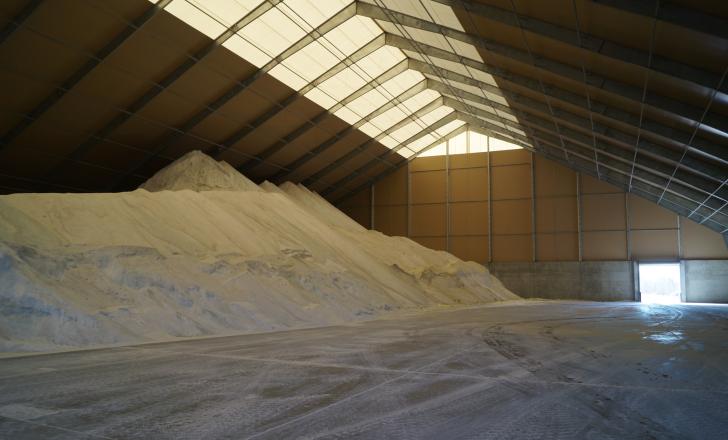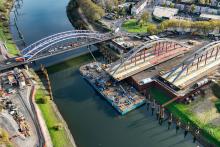The Tulsa Port of Catoosa has opened a new bulk salt storage facility for the Oklahoma Department of Transportation (ODOT) in the United States. Erected by Legacy Building Solutions, the massive tension fabric structure provides 45,359tonnes (50,000tons) of storage capacity for roadway deicing salt, nearly doubling ODOT’s available storage across the state. “ODOT will distribute the salt stored at this new location to maintenance distribution sheds ahead of impending snow or ice events during the winter,” s

The Tulsa Port of Catoosa new bulk salt storage facility for the Oklahoma Department of Transportation (ODOT) has nearly doubled ODOT’s available storage across the state
The Tulsa Port of Catoosa has opened a new bulk salt storage facility for the 5295 Oklahoma Department of Transportation (ODOT) in the United States.
Erected by5913 Legacy Building Solutions, the massive tension fabric structure provides 45,359tonnes (50,000tons) of storage capacity for roadway deicing salt, nearly doubling ODOT’s available storage across the state.
“ODOT will distribute the salt stored at this new location to maintenance distribution sheds ahead of impending snow or ice events during the winter,” said Craig Swengle, associate vice president of Dewberry Engineers Inc., the primary engineer/architect for public improvements at the Port of Catoosa. “Previously, salt was stored in the open and covered with tarps after being off-loaded from barges. The new building will protect the salt supply from being compromised by wind and precipitation.”
Measuring 61.87m wide by 121.92m long, the structure features 4.87m cast-in-place concrete walls and a rigid frame roof design that maximizes the usable interior space. To eliminate corrosion concerns, Legacy Building Solutions installed a PVC tension fabric roof with structural steel frame that peaks to a maximum height of 21.33m. All of the building’s steel, components and hardware are hot dip galvanized.
“Once the general contractor completed the footings and floors, Legacy installed the fabric building very quickly, in about two weeks,” said Swengle. “It was a very positive process with professional communication between Legacy and Dewberry throughout the project.”
The new salt storage building is primarily cladded with tan fabric, while also incorporating a white skylight to allow sunlight to illuminate the structure’s interior. The building is ventilated with mesh eaves and is designed to withstand winds of 145km/h and hold snow loads of9.07kg per 0.092sqm².
The Tulsa Port of Catoosa is said to have been strategically chosen as the site for the new facility because it allows ODOT to transport salt to the northern part of the state on a barge via inland waterway. This reduces material transport costs for the taxpayers and provides an avenue to procure extra salt shipments when road deliveries aren’t feasible.
Erected by
“ODOT will distribute the salt stored at this new location to maintenance distribution sheds ahead of impending snow or ice events during the winter,” said Craig Swengle, associate vice president of Dewberry Engineers Inc., the primary engineer/architect for public improvements at the Port of Catoosa. “Previously, salt was stored in the open and covered with tarps after being off-loaded from barges. The new building will protect the salt supply from being compromised by wind and precipitation.”
Measuring 61.87m wide by 121.92m long, the structure features 4.87m cast-in-place concrete walls and a rigid frame roof design that maximizes the usable interior space. To eliminate corrosion concerns, Legacy Building Solutions installed a PVC tension fabric roof with structural steel frame that peaks to a maximum height of 21.33m. All of the building’s steel, components and hardware are hot dip galvanized.
“Once the general contractor completed the footings and floors, Legacy installed the fabric building very quickly, in about two weeks,” said Swengle. “It was a very positive process with professional communication between Legacy and Dewberry throughout the project.”
The new salt storage building is primarily cladded with tan fabric, while also incorporating a white skylight to allow sunlight to illuminate the structure’s interior. The building is ventilated with mesh eaves and is designed to withstand winds of 145km/h and hold snow loads of9.07kg per 0.092sqm².
The Tulsa Port of Catoosa is said to have been strategically chosen as the site for the new facility because it allows ODOT to transport salt to the northern part of the state on a barge via inland waterway. This reduces material transport costs for the taxpayers and provides an avenue to procure extra salt shipments when road deliveries aren’t feasible.






